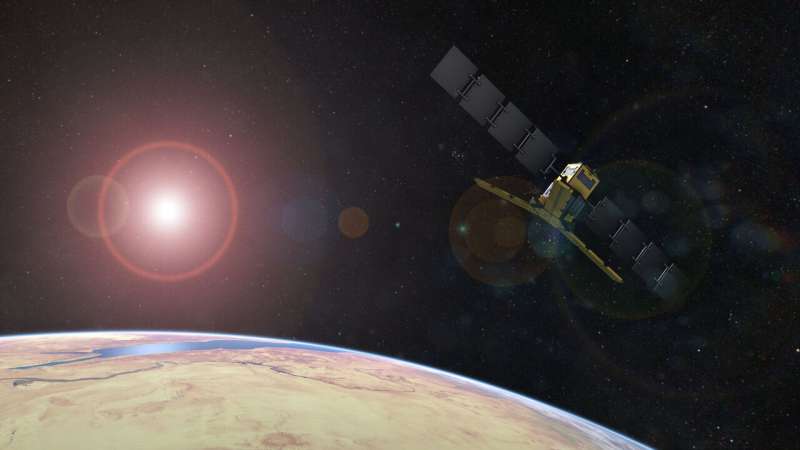Water mission takes on space weather

For well over a decade, ESA’s SMOS satellite has been delivering a wealth of data to map moisture in soil and salt in the surface waters of the oceans for a better understanding of the processes driving the water cycle. While addressing key scientific questions, this exceptional Earth Explorer has repeatedly surpassed expectations by returning a wide range of unexpected results, often leading to practical applications that improve everyday life. Adding to SMOS’ list of talents, new findings show that what was considered noise in the mission’s data can actually be used to monitor solar activity and space weather, which can damage communication and navigation systems.
The SMOS satellite carries a novel interferometric radiometer that operates at a frequency of 1.4 GHz in the L-band microwave range of the electromagnetic spectrum to capture ‘brightness temperature’ images. These images correspond to radiation emitted from Earth’s surface, which scientists then use to derive information on soil moisture and ocean salinity.
However, because of the wide field of view of SMOS’ antenna, it doesn’t just capture signals emitted from Earth’s surface, but also signals from the sun—which create noise in the brightness temperature images. Therefore, as a matter of course, a specific algorithm is used during the imaging processing procedure to remove this noise so that the data is fit for purpose.
However, scientists started to wonder if these sun signals could contribute to monitoring solar activity.
We think of the sun as providing the light and warmth to sustain life, but it also bombards us with dangerous charged particles in the solar wind and radiation. Changes in the light coming from the sun, known as solar flares, or in the solar wind, which carries coronal mass ejections, are referred to as space weather.
The SMOS satellite carries a novel interferometric radiometer that operates at a frequency of 1.4 GHz in the L-band microwave range of the electromagnetic spectrum to capture ‘brightness temperature’ images. These images correspond to radiation emitted from Earth’s surface, which scientists then use to derive information on soil moisture and ocean salinity. However, because of the wide field of view of SMOS’ antenna, it doesn’t just capture signals emitted from Earth’s surface, but also signals from the Sun – which create noise in the brightness temperature images. These stray signals are valuable data for helping to monitor solar activity. Credit: ESA/Planetary Visions
These flares or mass ejections can damage communication networks, navigations systems such as GPS, and other satellites. Severe solar storms can even cause power outages on Earth. Understanding and monitoring space weather is, therefore, important for early warnings and taking precautionary measures.
Manuel Flores-Soriano, from the University of Alcalá in Spain, said, “We found that SMOS can detect solar radio bursts and even weaker variations in emissions from the sun, such as the 11-year solar cycle.
“Solar radio bursts detected by SMOS brightness temperature signals from the sun are generally observed during flares that are associated with coronal mass ejections. We have also found a correlation between the amount of solar flux released at 1.4 GHz and the speed, angular width and kinetic energy of coronal mass ejections.”
These new results published in Space Weather describe how SMOS has the unique ability to observe the sun continually with full polarimetry—making it a promising instrument for monitoring solar interference affecting Global Navigation Satellite Systems such as GPS and Galileo, radar and wireless communications, and for early warnings of solar coronal mass ejections.
Raffaele Crapolicchio, who works in the SMOS mission team at ESA, noted, “It is very exciting to see how an idea I initially proposed at the European Space Weather Week back in 2015 has turned into these fruitful results.”
ESA’s Diego Fernandez added, “This research carried out though our Science for Society programme is further proof of how versatile the SMOS mission is and how we push the limits of our missions well beyond their main scientific objectives. Here we see a mission designed to observe our planet is also able to observe solar activity. More work will now be needed to build upon these initial results and create a dedicated retrieval algorithm for the L-band sun signal and to generate products for solar observations.”



 Creators of mankind
Creators of mankind Description of “Tall white aliens”
Description of “Tall white aliens” Where they came from?
Where they came from? About hostile civilizations
About hostile civilizations The war for the Earth
The war for the Earth “Tall white aliens” about eternal life
“Tall white aliens” about eternal life Video: “Nordic aliens”
Video: “Nordic aliens” Aliens
Aliens Alien encounters
Alien encounters The aliens base
The aliens base UFO
UFO Technology UFO
Technology UFO Underground civilization
Underground civilization Ancient alien artifacts
Ancient alien artifacts Military and UFO
Military and UFO Mysteries and hypotheses
Mysteries and hypotheses Scientific facts
Scientific facts


















